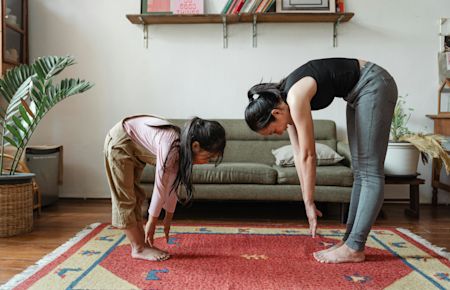‘The self-care tips that helped us lose weight’
If you’re trying to lose weight, look after the most important person in that journey: you.
Get an annual subscription to The Body Coach app for just £69.99 (usually £89.99)

Warming up and cooling down before and after workouts is a great habit to get into that’ll help you look after your body and get the most from your training.
When you warm up, you’re getting your body ready to exercise by increasing your internal body heat – and cool downs do the opposite. In both of them, you’ll do a range of movements that include dynamic (based on moving) and static (based on moving a joint and holding it still) stretches.
Stretching can feel uncomfortable. All of our bodies are different – some of us have tighter muscles, some are more flexible than others. Some people’s muscles may be loosened up through a quick 5-minute warm-up, while others might need to spend a bit more time stretching to loosen their muscles.
Uzo Ehiogu – who works with the Chartered Society of Physiotherapy – is an NHS physiotherapist, with expertise in sport and rehabilitation. “The one simple thing I tell my clients is: if it feels tight, it probably needs to be stretched – if it doesn’t feel restricted, it’s probably okay,” says Uzo.
So how often should we be stretching, how should we do it, and what do we need to know before we do?
Stretching tight muscles can help us improve our mobility and flexibility – two things that are slightly different, but related.
Mobility is the total range of motion available at a joint, and it can be influenced by lots of different factors. Flexibility refers to the soft tissues which can either increase or reduce the range of motion at a joint.
So, what’s the aim of a stretch? “We want joints to move through the fullest range of motion so that someone can achieve a particular task,” says Uzo.
Think of it like this: if you play tennis, there are certain body shapes you’ll want to make (i.e. think of when you’re doing a serve!). Now imagine if all those joints had a reduced range of motion and were tight – your ability to serve would be compromised. Similarly to a runner, for example – when we run, our knees and hips need to be able to extend. If our knees are bent because our hamstrings are tight, running can become hard work.
Now it’s easier to see how stretching – increasing the mobility and flexibility of our joints – can benefit the movement and exercise we do. Which brings us back to Uzo’s comment: if it feels tight, stretch it.
“Flexibility is a continuum,” says Uzo. There are people who are super tight, and those who are super mobile. A lot of this comes from genetics, he says, but some is acquired due to the type of activity we do.
We don’t know the full causes of inflexibility. “For years, it’s been looked at from a mechanical perspective, which means when you stretch, you’re stretching the bonds within the muscle and its associated tissues,” he says. “That’s the traditional view from the 80s and 90s.”
However, now research seems to be focused more around our nervous systems. Everyone has a capacity to increase flexibility, but there is a “neurological tolerance” for that stretch – i.e. your nervous system holds you back from stretching any further because it hurts.
For example, when you’re doing a stretch for the first time, you may get to the point where it starts hurting – pain receptors fire off, send a message to the brain of “hey, this hurts”, and so we stop. “Over time, however,” says Uzo, “If you continue to stretch, as you slowly move into that, your stretch tolerance increases, and your nervous system gets used to it.”
The longer you stretch, the more likely your tissue will change and improve your flexibility and mobility.
It’s hard to give hard and fast rules about which stretches are best for you – because everyone’s bodies are different.
However, Uzo says common muscles that become tight are hip flexors, quadriceps, and calves – so it might be worth seeing if these feel tight to you.
There are three things everyone should know about stretching before they go ahead, says Uzo.
The stretch needs to be long To achieve the relaxation of the nervous system and increase flexibility, the stretch needs to be 30 seconds and above – ”10 secs isn’t long enough,” he says. To maintain flexibility, you can do less, but to develop it, you can go up to 2 minutes.
You need tissues to be warm If you’re stretching out tight muscles, warm up the tissues by doing some cardio, like sitting on a bike, or doing a bit of jogging to help warm them up. It might be worth spending 15 minutes after a workout going into slow, long stretches – “that can be helpful,” says Uzo.
Consistency is key If you’re focused on stretching specific tight muscles, Uzo recommends doing 30-90 seconds stretches, in 2-3 sets, 3-4 times a week. Keeping regularity is important if you want to see results.
A great place to start would be to do a mobility session – during the exercises, you will be able to feel which muscles or positions feel tighter and more uncomfortable than others. It’s these muscles you may want to focus on moving forward.
Get going with one of the below:
This article was written by The Body Coach content team.